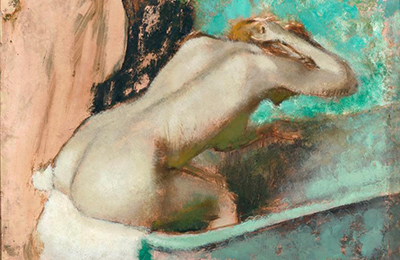 “I like to watch” said Peter Sellers’ cinematic creation Chauncey Gardiner in the 1979 movie Being There. Like Chauncey, Edgar Degas also enjoyed watching, from behind the flats in a theatre or in a corner of a brothel or spying into the laundry or peering through the bathroom keyhole.
“I like to watch” said Peter Sellers’ cinematic creation Chauncey Gardiner in the 1979 movie Being There. Like Chauncey, Edgar Degas also enjoyed watching, from behind the flats in a theatre or in a corner of a brothel or spying into the laundry or peering through the bathroom keyhole.
In paintings, drawings, pastels and monotypes, he chronicled the women he scrutinised. Mostly they are actively engaged, their bodies twisted into the necessary articulations of dancing, ironing or washing. They are also unaware of his presence, or so he likes to imagine. There is never eye contact. He doesn’t want to know them, talk to them or make love to them: he just likes to observe, to draw and then retreat.
Vincent van Gogh was convinced Degas had no real interest in what he saw, other than its animal spectacle or aesthetic appeal. After seeing Degas’ pastel drawings of women bathing in his brother Theo’s Paris gallery in 1888, he explained in a letter to his friend Emile Bernard that Degas,
… observes human animals who are stronger than himself screwing and fucking away and he paints them so well for the very reason he isn’t all that keen on it himself.
This was the general consensus about Degas. His fellow artists and contemporaries describe him as a man who never married and showed no interest in relationships with men or women. He was, they believed, an artist who recorded the world around him with detached interest, documenting with his pencil and the newfangled camera, but never engaging.
It is possible he was intrigued by the awkwardness of the woman’s pose, fascinated by the twist of her right arm scrubbing her neck, rather than by any sexual desire.
Degas is clearly entranced by the light reflected off the water and illuminating her right leg with a flash of vibrant pink and by her blouse and the aqua wallpaper, the patina of the bathtub and the shape of her solid body. But was he really disinterested in her comely buttocks perched uncomfortably on the side of the tin bath and her dangling breast, as van Gogh suggests?
Presumably, if she is sitting, he is at eye-level, sitting or on his knees, quite literally peering in through the keyhole. If he was simply interested in the colour and light, the arrangements of shapes and forms, then why not walk in and ask if he could paint her?
The answer may be found in a pastel of the same subject held in the collection of the Art Gallery of Ontario. In Woman and her bath, a maid, or possibly a friend, is pouring water from a jug onto the woman’s neck. It is a private moment as the two women undertake their daily ablutions. They would not expect to be interrupted; they would certainly not expect to be observed unawares.
So clearly some of the excitement Degas documents in the larger oil painting made from this pastel records his voyeuristic thrill of secrecy, of being unobserved.
There is no intimacy here, only proximity! Interesting comparisons are evident if we contrast Degas’ paintings of women at their toilette with Paul Bonnard’s portraits of his wife Marthe in the bath or recumbent on their bed. In so many of Bonnard’s paintings we feel his presence in the room, attending to his wife’s needs while simultaneously fascinated by the flow of light around her body.
Even though Bonnard was often painting the young girl he first lusted after rather than the woman she had become, there is a tangible intimacy. She takes no notice of him and again there is no eye contact, but you sense their familiarity.
In La Sieste from 1900, in the collection of the National Gallery of Victoria, Bonnard has quite obviously just risen from the bed. Dr Ted Colless, writing in Art and Australia in 1999, leaves us in no doubt,
We cannot help but delineate the scene’s graphic hardcore action at the same time as we absorb its dreamy, amorous mood: any response less that this is simply timid
Not so with Degas. The woman scrubbing her neck, and her now erased companion, are separated from the artist by a door, by his reticence and his focus on the play of light, the arrangement of shapes and the pictorial construction of space. But the intensity of the experience of watching – and the possibility of being discovered watching – is also palpably evident in this painting, which makes it both intriguing and somewhat unsettling.
Degas: A New Vision opens at the National Gallery of Victoria on 24 June 2016.
Here’s looking at: Edgar Degas’ Woman seated on the edge of the bath sponging her neck
Ted Snell, Winthrop Professor, Director Cultural Precinct, University of Western Australia
This article was originally published on The Conversation. Read the original article.
Image: Edgar Degas, Woman seated on the edge of a bath sponging her neck (Femme assise sur le bord d’une baignoire et s’épongeant le cou) c. 1880–95 oil and essence on paper on canvas 52.2 x 67.5 cm Lemoisne 1120 Musée d’Orsay, Paris (RF 1989 2) © RMN-Grand Palais (musée d’Orsay) / Hervé Lewandowski
